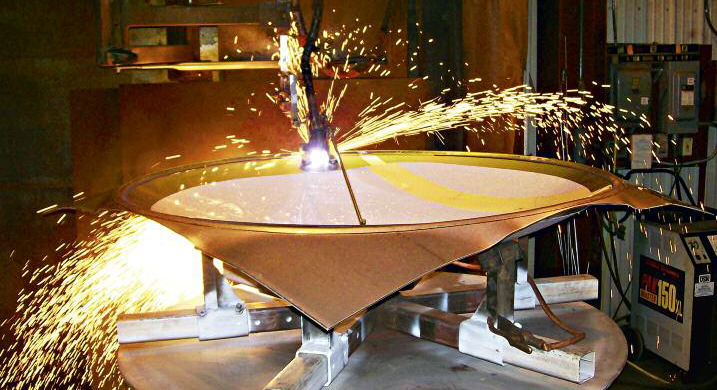Cutting of High Performance Austenitic Stainless Steel -- Water Jet, Plasma and Laser Cutting
2022.12.27
Water jet cutting
Water jet cutting is to use the nozzle to produce high-pressure water jet carrying fine abrasive particles for cutting. This method is very effective for cutting metal and non-metallic materials. The process uses large capacity pumps, and the demand for water and electricity is very large. This method can cut thick gauge stainless steel (>100mm) without producing heat affected zone (HAZ) and changing the metallurgical structure of the workpiece. Although the water jet cut is of good quality, when the cutting section is thicker, the groove angle of the section is larger. It is not economical to cut thin steel plates with this method, but multiple workpieces can be cut at a time when multiple thin steel plates are stacked.

Plasma cutting
Plasma cutting is the most common method for cutting all grades of austenitic stainless steel plates with a thickness of more than 25 mm. The design of plasma gun obviously improves the precision and cutting quality, which is an ideal process for straight line or special shape cutting. In some cases, the cutting quality of plasma cutting is very good, and it can be directly used or used as a welding joint without further treatment. Because plasma cutting does involve high temperature and local metal melting, the corrosion resistance of the incision is reduced. Portable plasma cutting machine can cut formed workpiece or sample. Underwater plasma cutting can reduce smoke and dust.
In plasma cutting, the grade and cutting thickness of stainless steel are important factors that must be considered when selecting plasma gas. Avoid the use of oxygen containing gas, because oxygen will cause the formation of chromium oxide layer on the surface, which will consume the chromium below the surface and reduce the corrosion resistance. Slight discoloration of the cut surface indicates chrome oxidation. If severe discoloration occurs, subsequent pickling or edging is required to restore corrosion resistance. The certified purity of nitrogen auxiliary gas shall be at least 99.95%, and the maximum oxygen content shall be 200ppm. In addition to N2, other gases commonly used for stainless steel plasma cutting include N2 and H2 or Ar and H2 mixed gases.
Gas velocity, arc current, nozzle design, cutting speed and other variables will affect the width, shape and quality of the incision. For stainless steels of different grades and thicknesses, the specific recommendations of the plasma cutting equipment manufacturer should be consulted.

laser cutting
In laser cutting, the laser beam melts the material, while the nitrogen jet blows the molten liquid away from the incision. Nitrogen prevents oxidation and loss of corrosion resistance. When laser cutting stainless steel, nitrogen pressure shall be greater than oxygen pressure when cutting carbon steel. In order to effectively blow away molten metal, nitrogen pressure shall increase with the increase of material thickness. Compared with plasma cutting, laser cutting speed is faster, the incision width is narrow, and the incision quality is high. It can usually be used directly without further treatment of the incision. Compared with plasma cutting, the disadvantage of laser cutting is that the cutting thickness is limited. The current laser cutting equipment can only cut stainless steel with a maximum thickness of no more than 12mm. Laser cutting machine can cut high performance austenitic stainless steel and standard austenitic stainless steel into final size without additional machining. There is little difference in laser cutting characteristics between high performance and standard austenitic stainless steel.

Previous:Metal material corrosion is very worthy of attention
Related Information
- Industry news
- The tap or drill bit breaks in the hole, how to fix it?
- Why do airplanes use rivets instead of welding?
- Why are engineering drawings all blueprints?
- How is a ping pong ball made? It turns out that it is made of two pieces of plas
- What to do if quality is abnormal? Doing these 3 things well is the key!
- Weekly News 9.7-9.13
- Huawei's three-fold screen is approaching, and the domestic supply chain is wait
- Innovative application of digital twin technology in integrated die-casting prod
- 5 types of carbide cutting tools, what are the differences? Save this article an
- Global manufacturing PMI in June was 49.5% | Weekly News 7.6-7.12
- Raw material defects | Machining special operations and practical cases 109
- No wonder Toyota stamping is so good: a day in the life of a Toyota stamping sho
- Analysis on the development trend and demand of China's mold industry
- How many types of sealing rings are there in machinery? What are they used for?
- Hangfa, Hangfa, a scar on the hearts of machine processing workers
- How to mill a large arc surface with a small cutter?
- Dynamics of the processing center of the process! What is the fundamental reason
- 500 ° C ultra -strong aluminum alloy! This problem is overcome
- How much do you know about the hometown of machine tools and molds, how much do

 BACK
BACK MT HOME
MT HOME Navbar
Navbar